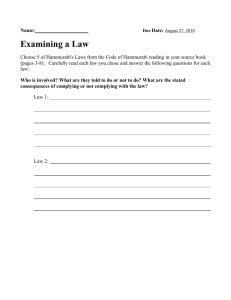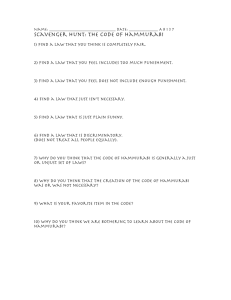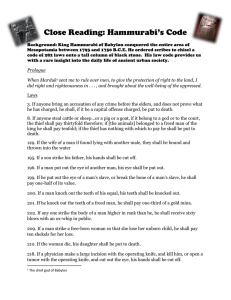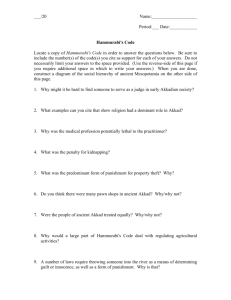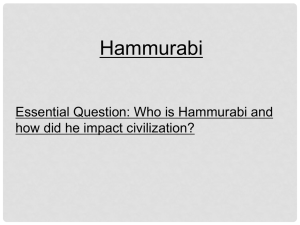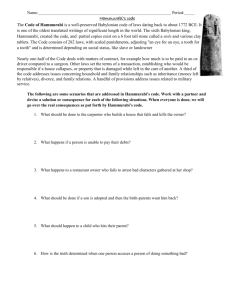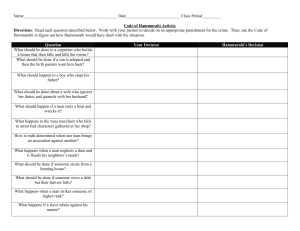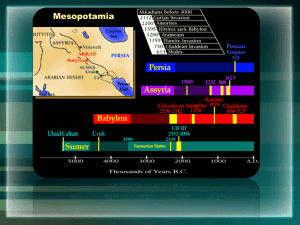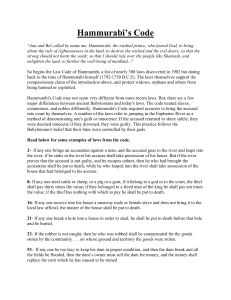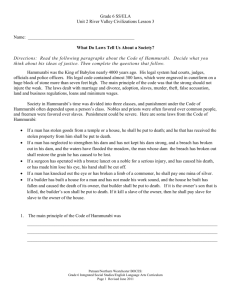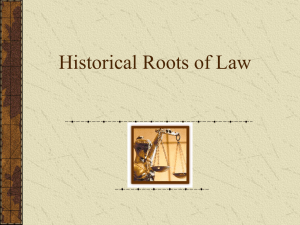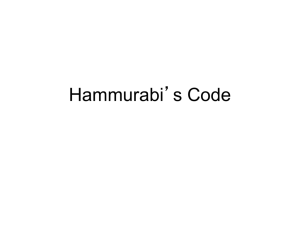The Code Of Hammurabi
advertisement
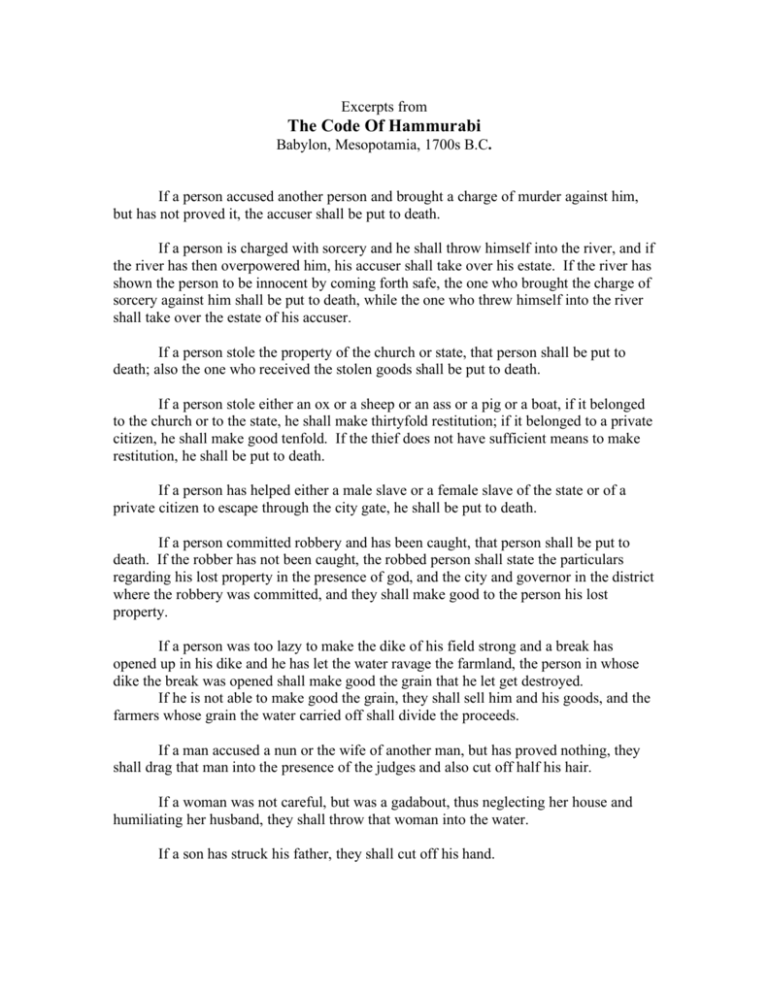
Excerpts from The Code Of Hammurabi Babylon, Mesopotamia, 1700s B.C. If a person accused another person and brought a charge of murder against him, but has not proved it, the accuser shall be put to death. If a person is charged with sorcery and he shall throw himself into the river, and if the river has then overpowered him, his accuser shall take over his estate. If the river has shown the person to be innocent by coming forth safe, the one who brought the charge of sorcery against him shall be put to death, while the one who threw himself into the river shall take over the estate of his accuser. If a person stole the property of the church or state, that person shall be put to death; also the one who received the stolen goods shall be put to death. If a person stole either an ox or a sheep or an ass or a pig or a boat, if it belonged to the church or to the state, he shall make thirtyfold restitution; if it belonged to a private citizen, he shall make good tenfold. If the thief does not have sufficient means to make restitution, he shall be put to death. If a person has helped either a male slave or a female slave of the state or of a private citizen to escape through the city gate, he shall be put to death. If a person committed robbery and has been caught, that person shall be put to death. If the robber has not been caught, the robbed person shall state the particulars regarding his lost property in the presence of god, and the city and governor in the district where the robbery was committed, and they shall make good to the person his lost property. If a person was too lazy to make the dike of his field strong and a break has opened up in his dike and he has let the water ravage the farmland, the person in whose dike the break was opened shall make good the grain that he let get destroyed. If he is not able to make good the grain, they shall sell him and his goods, and the farmers whose grain the water carried off shall divide the proceeds. If a man accused a nun or the wife of another man, but has proved nothing, they shall drag that man into the presence of the judges and also cut off half his hair. If a woman was not careful, but was a gadabout, thus neglecting her house and humiliating her husband, they shall throw that woman into the water. If a son has struck his father, they shall cut off his hand. If a man has destroyed the eye of a member of the aristocracy, they shall destroy his eye. If he has broken another man’s bone, they shall break his bone. If he has destroyed the eye of a commoner or broken the bone of a commoner, he shall pay one mina of silver. If he has destroyed the eye of another man’s slave or broken the bone of a man’s slave, he shall pay one-half of the slave’s value. --------------------------------------------------------------------------Questions to consider: 1. Before the Code of Hammurabi was written on a stone pillar for all to see, laws were held in peoples’ memories and transmitted orally. Why would a written legal code be an improvement over an oral set of laws? 2. Were some people more important than others in ancient Babylon? Who was important and who was not so important? 3. Which was worse, committing a crime against a private person or against the state? How do you know? 4. In describing the proper punishment for a crime, the Old Testament of the Bible says, “An eye for an eye, and a tooth for a tooth.” Do you think there might be any connection between the Bible and Hammurabi’s Code? Why? 5. Some of the punishments in Hammurabi’s Code seem harsh to us. Can you think of any reasons why ancient Babylon would have such harsh penalties? 6. In some ways, the government of Babylon might have been more generous to its citizens than is our government here in the United States. What would be an example of this generosity? --------------------------------------------------------------7. Although a stone pillar with Hammurabi’s Code has been discovered, pieces of it are chipped off. There is an old but persistent rumor that one of the Code’s most important laws is missing. This old rumor, passed down from the ancient Babylonians to the ancient Egyptians to the classical Greeks, is supported by a small fragment of a papyrus scroll found buried in the ruins of the great library of Alexandria. It seems the Babylonians had a problem with skate boarders. Your task is to recreate the ancient Babylonian law that prohibited skate boarding on sidewalks as the law might have originally appeared in Hammurabi’s Code. from studentsfriend.com Essay Question relating to Hammurabi’s Code and the use of primary and secondary sources We looked at two sources of evidence regarding Hammurabi’s Code: excerpts from the Code itself and a play about the Code. What did you learn from the primary source that you did not learn from the secondary source? What did you learn from the secondary source that you did not learn from the primary source? What are the strengths and weaknesses of primary and secondary sources? …………………………………… Some thoughts about this question: The primary source gives us basic factual information about the Code. Assuming the translation is accurate, this is the real deal, not subject to anybody’s opinion or interpretation. But the information we get here is limited; it doesn’t provide any context to help us understand why the Code came about or how it was used, etc. The secondary source, on the other hand, provides this kind of background information and context, but it is a fictional account written by a modern person, so we can’t be sure the author got it right. These characteristics are true of primary and secondary sources in general. One isn’t better than the other. In trying to understand an historical event, we can benefit from both kinds of sources. …………………………………… For suggested essay question formats, go to the “Lesson Plans & curriculum support ” page of the Student’s Friend website and see “General Lesson Plans. ” http://www.studentsfriend.com/aids/curraids/curraids.html …………………………………… If students need a refresher on primary and secondary sources, they can review Page 2, Topic 1 in the Student’s Friend, which is copied below: 1. primary and secondary sources We learn about the past from historians. But, where do historians get their information? Usually, they study primary sources, which are sources created at about the same time as the event being studied, often by people involved in the event. Examples of primary sources include artifacts uncovered by archeologists, art works, government records, diaries, letters, speeches, and newspaper articles. Historians also study secondary sources. These are sources created after the event by people not involved in the event. Examples of secondary sources include history books, textbooks, encyclopedias, and the Student's Friend. After historians examine their sources, they write histories based on their understanding of the truth. But, what they write may be influenced by their own opinions or by lack of information. It is not possible for historians to know everything about a past event, so they must rely on the evidence left behind in the form of primary and secondary sources. If new evidence is found, interpretations of history can change. from studentsfriend.com
